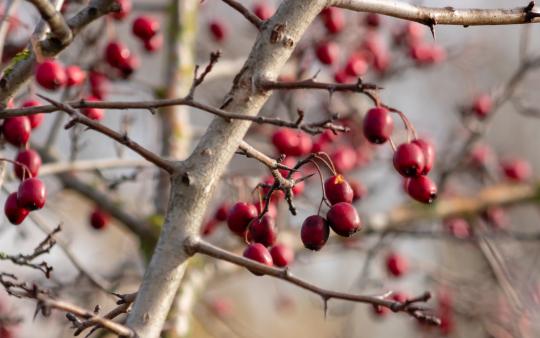What is Hawthorn?
Hawthorn is a genus of small, flowering, deciduous trees and shrubs, scientifically known as Crataegus spp., which is part of the rose family (Rosaceae) and is known for their thorns, white or pink flowers, and red berries called "haws".
Hawthorn (Crataegus spp) has been used for centuries, both as a curative and in ceremonies and rituals. Believed to have spiritual force, it is especially valued for its capacity to open the heart to love, mend sadness, and develop courage. Ancient Greeks carried hawthorn boughs in wedding ceremonies as a symbol of fertility and hope, and the Romans hung them over new babies’ bassinettes as a form of protection.
A member of the rose family, hawthorn has been long-revered for its medicinal potency as well as its uplifting properties. Its berries were even noted by the first century Greek herbalist Dioscorides as a treatment for heart health, becoming known as “food for the heart!” Hawthorn is one of the most powerful herbs in Western medicine, believed to support healthy cardiovascular function as well as other aspects of the body’s systems.
Crataegus spp is Berries, Flowers and Hawthorn Leaves
Genus: Hawthorn (more than 280 species exist!)
Common name: Hawthorn, mayflower, thornapple
Parts used: Fruit (berries), flowers, and leaves
Taste: Sweet, sour, bland, astringent
Energy: Warm and slightly moist
Active constituents: Flavonoids, flavonglycosides (quercetin, rutin, hyperoside and vitexin), and procyanidins (catechin and epicatechin), saponins, ascorbic acid
Dosage:
• Tincture (1:5): 5 ml, 3 times daily
• Tea 1-2 tsp dried berries. Add 8oz hot water, steep for 1 hour. Drink 3 cups daily.
How Does Hawthorn Benefit the Human Heart?
Each day our hearts pump over 7000 litres of blood through a vast network of capillaries, arteries, and veins, delivering nutrients and removing waste products from our trillion of cells. Considered one of the very best trophorestoratives for the heart, hawthorn’s normalizing effect can be useful in any type cardiac ailment to restore strength, tone, and function, and can either stimulate or depress the heart and circulation depending upon the need. Hawthorn berries have an affinity for the coronary arteries in the heart and assist in dilating the coronary blood vessels allowing for increased blood supply and oxygen, thereby improving heart muscle contraction.
Trophorestoratives are nutritive foods or herbs that have an affinity for specific tissues or organ systems and bring nourishment, vitality, and strength to help restore normal function. They can be safely consumed for long periods of time without harm or negative side effects.
Hawthorn may be beneficial in treating angina, mild congestive heart failure, hypertension, and mitral valve weakness. It also tones the capillaries, veins and arteries in the cardiovascular system and is useful for atherosclerosis and intermittent claudication (exercise-induced leg cramps caused by arterial obstruction).
The antioxidant and anti-inflammatory compounds found in hawthorn’s flavonoids and flavonglycosides cool and repair inflamed capillary tissues, decrease capillary permeability and fragility, and helps to increase intracellular vitamin C levels. Hawthorn also aids in the stabilization of collagen fibres in the capillaries, providing fluidity and strength to capillary beds and reducing the formation of arterial plaques or deposits.
A systematic review conducted in 2019 found that hawthorn can significantly lower blood pressure in people with stage 1 hypertension if used for at least twelve weeks. Another study showed that patients with mildly high blood pressure who took 500 mg of hawthorn extract for ten weeks found their resting diastolic blood pressure had been reduced, as was their anxiety.

Health Benefits of Hawthorn Supplements
Hawthorn’s trophorestorative abilities aren’t just limited to the heart! It can also benefit other organ systems of the body.
Breathe easy. Hawthorn may also help open the chest and ease breathing. Dr. Deborah Frances, ND, found that patients with both tight breathing due to rigidity of the chest and allergic asthma were helped with the use of hawthorn.
Nerve tonic. Herbalist David Winston, one of the first to use hawthorn clinically for ADD and ADHD both in children and in adults, found that hawthorn was helpful for a restless or unfocused mind. I often prescribe and include hawthorn to assist in comforting nervous unrest, calming and reducing anxiety, helping with insomnia, and soothing menopausal mood swings.
A gut feeling. A species of Crataegus fruit has long been used in Traditional Chinese Medicine to treat digestive distress and food stagnation from excess meat or greasy food. It also assists in soothing the mucosa of the stomach and can lower cholesterol levels.
Gotta go! Hawthorn is considered a mild diuretic and may provide some protection for the kidneys, supporting the integrity of its capillaries.
How to Make Hawthorn Elixir?
Enjoy the healing benefits of hawthorn in this sweet syrup you can make at home!
Ingredients:
4 c fresh hawthorn berries (or 2 c dried)
2 vanilla beans
2 cassia cinnamon sticks
1 Tbsp cardamom pods
1.75 L brandy
1 c raw, local honey (or to taste)
Instructions:
1. Put dry ingredients into a 2-litre glass jar, pour brandy over top, and secure with lid.
2. Leave in a cool dark place. Shake daily for 4 to 6 weeks.
3. Strain liquid into another glass jar, then stir in honey until dissolved. Decant into smaller bottles for a little elixir power on the go!
Dosage:
Yields about 2L of elixir.
½-1 tsp. in some warm water daily makes a wonderful, tonifying drink.
For increased therapeutic effect 1 tsp. 3x/day is recommended.
*adapted from Mountain Rose Herbs
Hawthorn Contraindications and Side Effects
Hawthorn is a gentle, non-toxic herbal tonic and is suitable for long term use, particularly for those with a history of heart conditions. Caution is advised, however, for those taking pharmaceutical drugs for heart conditions such as digoxin, beta-blockers, calcium channel blockers, or nitroglycerin. Hawthorn should not be used if you are pregnant or breastfeeding, and shouldn’t be used by children. Please consult your healthcare practitioner before embarking on any herbal routine.
Got a green thumb? Here are 10 healing herbs you can grow yourself.









